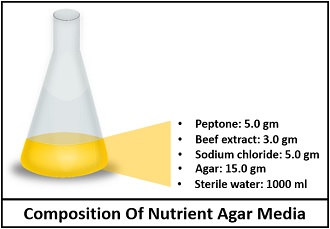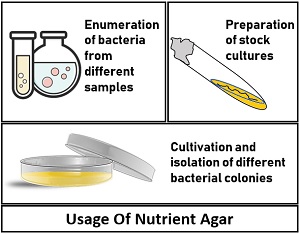Nutrient agar is a standard media used for growing and isolating a broad class of microorganisms. It is the most popular media generally available in all laboratories to enumerate different bacteria. The enumeration of different bacteria from different samples like soil, water, sewage, food etc., can be carried out by using such media by employing different plating methods (pouring, spreading and streaking).
Besides culturing and isolating different bacteria, the nutrient media is frequently used to maintain and preserve pure cultures. We should remember that it is a supportive media that provides a nutrient base for developing less or non-fastidious organisms.
The media also provides the solid medium to subculture bacterial isolates and checks the purity before biochemical and serological tests. This post mainly discusses the definition, composition, principle and media preparation of the nutrient agar medium along with its uses and quality control.
Content: Nutrient Agar Media
Definition of Nutrient Agar
Nutrient agar is the ordinary basal media that provides a suitable medium for cultivating non-fastidious microbes with no special growth requirements. It is one of the functional types of culture media, which differs from the enriched, selective and differential media.
We can turn the nutrient agar media into an enriched medium by integrating serum and other biological fluids. The formulation of supportive nutrient agar can function as a selective media after incorporating selective agents like antibiotics. Similarly, if the nutrient agar becomes saturated with specific dyes or chemicals, it will function as a differential media.
Composition of Nutrient Agar Media
The composition of nutrient agar media includes the following ingredients per 1000 ml of distilled water:

- Peptone: 5.0 gm
- Beef extract: 3.0 gm
- Sodium chloride: 5.0 gm
- Agar: 15.0 gm
- pH: 7.4 ± 0.2 at 25°C
The composition of nutrient broth is the same as above, but one should skip the addition of solidifying agar. We could easily prepare nutrient broth from the readymade media by taking 13 grams of nutrient broth powder per litre of sterile water.
Principle
Nutrient agar media supports the culturing and isolation of various non-fastidious bacteria by providing principal sources for their growth.
- Peptone provides the principal organic nitrogen source from the enzymatic digest of proteinaceous materials, e.g., meat, casein, gelatine etc. It supplies nitrogen and comprises pure amino acids or nitrogenous compounds that the bacteria can readily utilize. Different bacteria utilize peptone differently, depending upon the constituents of peptone and method of digestion.
- The beef extract is a water-soluble extract of the animal tissue, which provides key elements like vitamins, carbohydrates, nitrogen, and salts necessary to obtain bacterial growth on the media.
- Sodium chloride or common salt maintains the osmotic equilibrium by keeping the osmotic concentration of the media similar to that of bacterial cytoplasm.
- Agar is a complex carbohydrate obtained from certain marine algae. It serves as a chief material in the culture media, which provides a solid growth medium. It is the component that bacteria do not utilize, as agar does not have any nutritive value. The gelling and liquefying temperature of agar is 45°C and 95 °C, respectively.
- Distilled or sterile water is free of impurities like calcium, chlorine, fluorine etc. and provides a pure water source essential for the growth of and development of bacteria. It also functions as the medium through which various nutrients translocate into the bacterial cells.
Media Preparation
To prepare nutrient agar media, we need to add the above ingredients into the conical flask. Then, add one litre of distilled water into the flask. Afterwards, Stir the components well until homogeneity, and autoclave the solution at 15lbs (121 degrees Celsius) for 30 minutes. After autoclaving, bring the media to the laminar airflow chamber.
Then, one can perform plating methods of their own choice by inoculating bacterial culture in the solid growth media. We must follow the incubation of the culture plates for up to 24-42 hours at an optimum temperature of 35 degrees Celsius. We can set the leftover media in the refrigerator.
Uses of Nutrient Agar
Following are the applications of the nutrient agar media:

- Nutrient agar is an indispensable standard media for cultivating non-fastidious organisms.
- It is also required in the subculturing and maintenance of the pure culture.
- Nutrient agar is the standard media whose composition can be altered to function like enriched, selective or differential media.
- It provides a preliminary testing media that checks the presence or absence of any harmful microbes before performing any biochemical or serological tests.
- Its usefulness is not limited to the areas mentioned above but also aids in preparing bacterial lawns to perform antibiotic sensitivity tests.
- It is also applicable for the bacteriological examination from a variety of materials or samples.
Quality Control
To maintain the nutrient media’s quality and obtain the best results, the pH of the nutrient agar should be 6.8 ± 0.2. The prepared nutrient agar should appear as a clear homogeneous solution without any lumps and haziness.
Autoclave the mixtures of the media until the appearance of slightly opalescent or light amber colour. While performing the plating method, one should always prepare a control or standard plate to compare the growth with the culture plates.
The incubation of the bacteria requires 35 ± 2°C temperature and a time period of 18-48 hours, depending upon the different kinds of bacteria and their growth requirements.
Conclusion
Therefore, we can conclude that the nutrient agar is a basic media for culturing various non-fastidious bacteria whose isolation is based on their culture characteristics like growth pattern, texture, margin and elevation of the bacterial colonies.
It caught my attention when you mentioned how nutrient agar offers suitable media for cultivating microbes with no special growth requirements. I’ll be sure to consider this if I ever need sample-ready culture media in my experiments in the future.